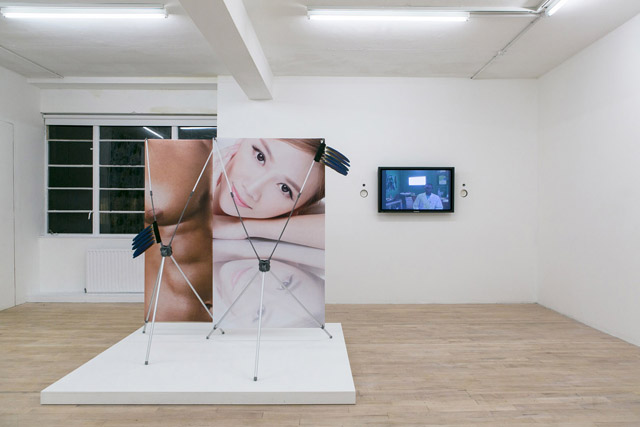Welcome to 2014, where ‘Fulfilment Centres’ are places that help you sell stuff. As Amazon puts it, you just have to send your items to them and they “[deliver] the products to your customers from our network of Fulfilment centres.” In a month-long exhibition for The Sunday Painter, London collective N/V_PROJECTS trace a link between the hyperbolic name for these warehouses and the literature on “Wellness” and “New Age” lifestyles that “occupies a surprisingly large portion of storage racks” within them. We live in an age where enterprise uses signifiers of spiritual betterment to sell you things that detract from it; where many try to buy access to self-realisation, to their own centres, by dropping The Power of Now or Reiki for Dummies into their virtual baskets.
Fulfilment Centre is an exhibition with its focus on this friction between ‘self-improvement’ according to Capitalism and the Eastern philosophies it borrows from to meet its own ends. The first work to be seen in the space, Lewis Teague Wright’s ‘Suspicions In, For, Without Paradise’, embodies this contrast sharply with its thin twists of copper plated bronze entwined around a pillar of corrugated galvanised steel. These copper rings set off a theme of adornment and appropriation, like “healing” copper bracelets bolstered onto Western wrists, making it even more affecting to realise that the sturdy, industrial pillar they’re attached to is of course a sheet of metal: completely hollow.

Appropriation is explored even more explicitly in two pieces that sit in conversation with one another, Timur Si-Qin’s ‘Deliver me from dipolar spirits’ and Christopher Kulendran Thomas’ re-contextualisation of Prageeth Manohansa’s painting ‘Ganesh XI’ in an extract from his When platitudes become form series. With this ongoing work, Kulendran Thomas explains, “I reconfigure, for the Western art market, artworks by some of Sri Lanka’s most celebrated young artists. This radical re-marketing of the island’s contemporary art raises funds to resist the oppression of communities displaced by civil war, channelling resources that are not under government control to the formerly Tamil-occupied territories of the North and East of the country.” The result of that mission in Fulfilment Centre is a somewhat phallic painting of the Hindu elephant-headed god Ganesh placed over a Nike t-shirt canvas, the iconic tick set jarringly off-kilter in a way emphasising its masculine shape.
The t-shirt’s positioning suggests the exact outline of the “perfect” male torso, sculpted in seams; opposite, Si-Qin’s ‘Deliver me from dipolar spirits’ counter-acts with an extreme close-up of a man’s chest and stomach, all muscly and hair-free. In Si-Qin’s work, the torso (which is displayed on his staple aluminium X-banner stand that could have been taken straight from the conference room) is next to a mirror-image of a woman’s face, airbrushed into the uncanny valley and framed by her delicately manicured hands. In Si-Qin’s installation, “dipolar” qualities are both separate from and inherent to one another, and so these gender ideals are presented together, both propping prop up the flipside of a display promoting “PEACE” with the star and crescent and crucifix of a Chinese yin and yang symbol. The fusion is crude, as is the commodification of Eastern and religious philosophies. This piece more than any other walks the “fine line between cynicism and sincerity” referred to in the Fulfilment Centre press release, directly appropriating its object of critique to form the crux of the space, the other pieces orbiting.

The most dynamic, immediate work, though, is that of Julie Born-Schwartz, whose mixed media installation ‘I had an expectation that it would fade’ creeps off the wall and across the space, its disembodied arm taking agency as it claws out of nothingness. Formed of hard unfeeling gold and peculiarly skinless, the arm is presented on a backdrop of what looks like skin cells under a microscope, digitally rendered and printed on paper that spills from wall to floor. The fingertips touch lightly on a pyramid; the hand reaching for spirituality, or at least a symbol of it.
Elsewhere along this cycnical-hopeful spectrum of belief and self-improvement are Tyra Tingleff’s painting on raw linen, ‘Respect pop but we’re broken up’, the rough and dense quality of which reveals its shapes slowly, and Neil Beloufa’s award-winning 2007 film ‘Kempinski’. Seemingly named for the luxury hotel chain, the film sees actors in a variety of suburban and rural spaces in Mali talk about their ideas of the future under the buzz of artificial light. “Once you think about something, you have it in front of you,” says one of Beloufa’s subjects. That future is now: think of anything you desire, and it’s probably waiting to fulfil you in a centre not too far away. It’s a hollow, steely promise. Be careful what you wish for. **













